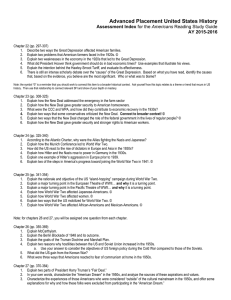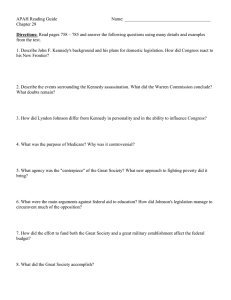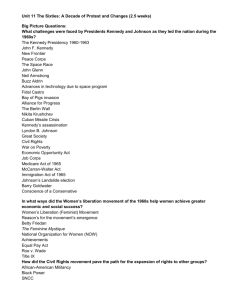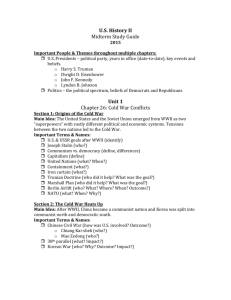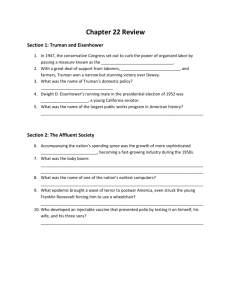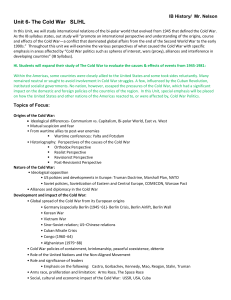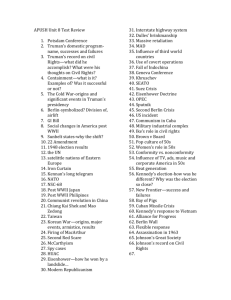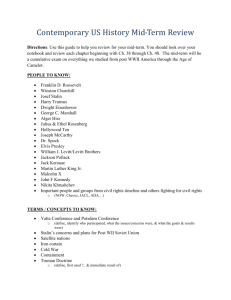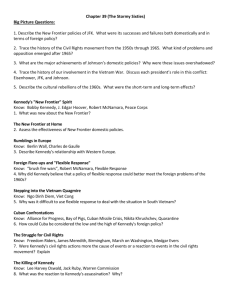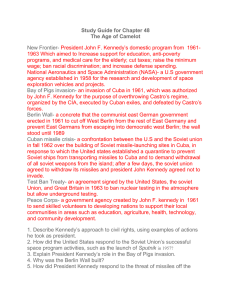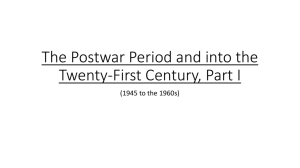File
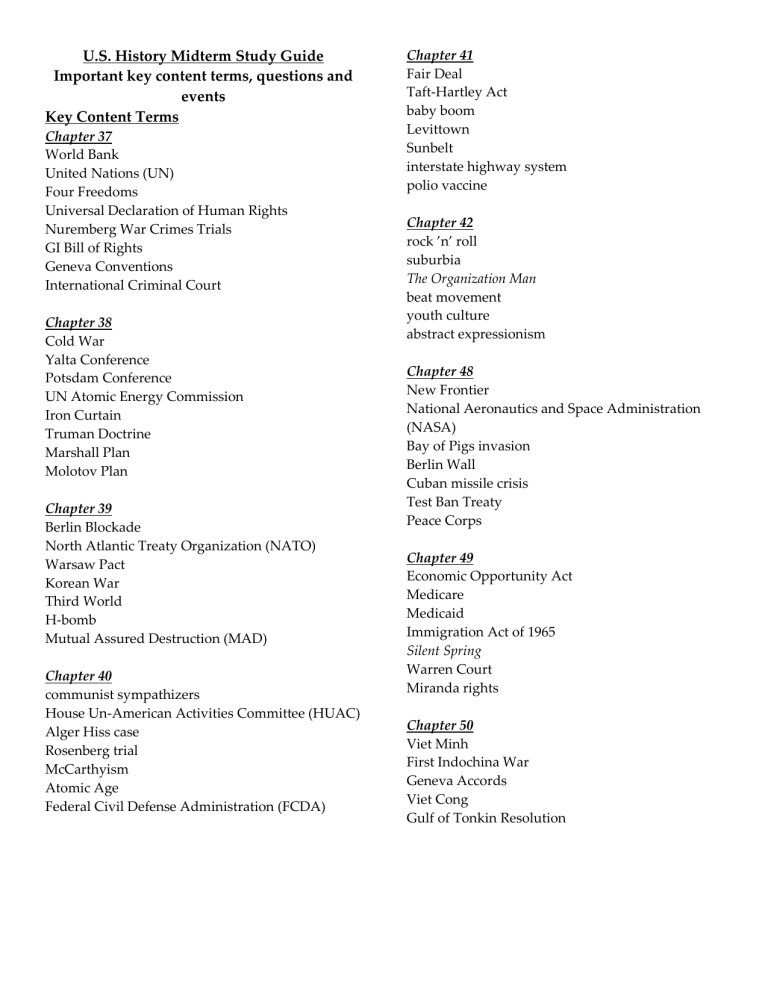
U.S. History Midterm Study Guide
Important key content terms, questions and
Key Content Terms events
Chapter 37
World Bank
United Nations (UN)
Four Freedoms
Universal Declaration of Human Rights
Nuremberg War Crimes Trials
GI Bill of Rights
Geneva Conventions
International Criminal Court
Chapter 38
Cold War
Yalta Conference
Potsdam Conference
UN Atomic Energy Commission
Iron Curtain
Truman Doctrine
Marshall Plan
Molotov Plan
Chapter 39
Berlin Blockade
North Atlantic Treaty Organization (NATO)
Warsaw Pact
Korean War
Third World
H-bomb
Mutual Assured Destruction (MAD)
Chapter 40 communist sympathizers
House Un-American Activities Committee (HUAC)
Alger Hiss case
Rosenberg trial
McCarthyism
Atomic Age
Federal Civil Defense Administration (FCDA)
Chapter 41
Fair Deal
Taft-Hartley Act baby boom
Levittown
Sunbelt interstate highway system polio vaccine
Chapter 42 rock ’n’ roll suburbia
The Organization Man beat movement youth culture abstract expressionism
Chapter 48
New Frontier
National Aeronautics and Space Administration
(NASA)
Bay of Pigs invasion
Berlin Wall
Cuban missile crisis
Test Ban Treaty
Peace Corps
Chapter 49
Economic Opportunity Act
Medicare
Medicaid
Immigration Act of 1965
Silent Spring
Warren Court
Miranda rights
Chapter 50
Viet Minh
First Indochina War
Geneva Accords
Viet Cong
Gulf of Tonkin Resolution
Key Content Questions
Chapter 37
1. Describe the influence of U.S. leaders Franklin and Eleanor Roosevelt on the UN Charter and
Declaration of Human Rights.
2. Explain how the establishment of the International Monetary Fund,World Bank, and the
General Agreement on Tariffs and Trade (GATT) helped countries and the world economy recover after World War II.
3. Summarize important characteristics of the “MacArthur Constitution” prepared by officials serving under Douglas MacArthur in Japan.
4. How would a World War II veteran have described the benefits of the GI Bill of Rights? How did these benefits help returning soldiers make the transition back to civilian life?
5. What might returning African American veterans have said about their ability to collect their
GI benefits?
6. Analyze how the end of World War II affected employment opportunities for women.
Chapter 38
1. Compare and contrast the goals and visions of the United States and Soviet Union for postwar Europe.
2. Describe aggressive Soviet acts that provoked the United States into following a policy of containment.
3. What did the “Iron Curtain” speech reveal about the political geography of Europe in 1946?
4. Explain how conditions in Great Britain contributed to the expanding role of the United
States in world affairs.
5. Describe how the Truman Doctrine committed the United States to a foreign policy based on the idea of containment.
6. Why was a rebuilt Europe important to the United States?
7. What impact did Marshall Plan aid have on Western Europe? What was the impact on
Eastern Europe?
8. Identify the ways the Cold War was different from previous conflicts.
Chapter 39
1. Trace the events that led the Soviets to impose the Berlin Blockade.Why did the blockade fail?
2. How did the United States respond to Mao Zedong’s rise to power in China?
3. Analyze the rationale behind the U.S. use of armed force in an effort to contain communism in Korea. How did the United Nations respond?
4. Describe at least two effects of the Korean War.
5. Besides the use of armed force in Korea, identify at least three containment strategies the
United States applied in Latin America, North Africa, and Asia during the Cold War.
6. What was the reasoning behind the foreign policy known as brinksmanship, and how was this policy tested in Asia?
Chapter 40
1. Identify the two main threats to security that created anxiety in Americans during the Cold
War. Do those threats still exist? Explain.
2. Evaluate the success of government loyalty checks and congressional investigations in uncovering subversives.
3. Compare the actions of Klaus Fuchs and Julius and Ethel Rosenberg.
4. Why do you think Americans allowed Senator McCarthy to persecute suspected subversives, even though he offered no evidence to back up his charges?
5. Explain why the harnessing of atomic energy brought great hopes as well as great fears.
6. Why did the development of the H-bomb lead many Americans to conclude that their country must maintain peace with the Soviets?
Chapter 41
1. Explain what caused the rise in prosperity in the United States following World War II.
2. How did American businesses respond to growing consumerism in the postwar years?
3. Describe how the economy shifted during the 1950s. Give examples.
4. Trace the changes in the American workforce during the 1950s.
5. What impact did the GI Bill have on the housing industry?
6. What technologies fostered migration to the Sunbelt? What role did the automobile play in migration to the suburbs?
7. Identify at least three defining characteristics of the 1950s.
8. Provide at least three examples of how technological innovations changed American society during this era.
Chapter 42
1. Summarize what Lewis Mumford disliked about the first Levittown.
2. What positive effects did migration to the suburbs have on families, as shown by the memories of Doris Kearns Goodwin?
3. Write a general description of what suburban life was like in the 1950s.
4. Describe the typical beatnik.
5. What role did rebellion play in the formation of the new youth culture of the 1950s?
6. Explain how the films The Wild One and Rebel Without a Cause reflect the era in which they were created.
7. What characteristics did the works of beat writers and abstract expressionists of the 1950s have in common?
Chapter 48
1. Describe Kennedy’s approach to civil rights, using examples of actions he took as president.
2. How did the United States respond to the Soviet Union’s successful space program activities, such as the launch of Sputnik in 1957?
3. Explain President Kennedy’s role in the Bay of Pigs invasion.
4. Why was the Berlin Wall built?
5. How did President Kennedy respond to the threat of missiles off the coast of the United
States during the Cuban missile crisis?
6. Why was the hotline between the United States and the USSR established?
7. How did President Kennedy address his concern about the spread of communism to developing countries?
Chapter 49
1. Examine the idea that Johnson’s Great Society was all about expanding on President
Kennedy’s social programs.
2. Contrast liberal and conservative views on the role of government as reflected in the beliefs of
Johnson and Goldwater.
3. How was the VISTA program similar to the Peace Corps?
4. Explain how Johnson’s Great Society programs addressed health insurance and access to health care.
5. How did Johnson increase the federal government’s role in education?
6. What did Johnson mean when he said that the Immigration Act of 1965 repaired “a very deep and painful flaw in the fabric of American justice”? How did the act transform American society?
7. List some criticisms of Johnson’s reforms. What do these criticisms reveal about the heart of the debate over the Great Society?
8. Analyze the Warren Court decisions in Baker v. Carr and Reynolds v. Sims in terms of their effects on states.
Chapter 50
1. Identify two opposing American views of the First Indochina War. Which view won out?
2. List the steps taken by presidents Truman, Eisenhower, and Kennedy that increasingly involved the United States in Vietnam. What reason would each president have given for the steps he took?
3. What were President Johnson’s goals in Vietnam?
4. Summarize three points that the hawks made in favor of escalating the war during the foreign policy debates of the Johnson administration.
5. Summarize three points that the doves made against escalation.
6. How did LBJ escalate the war in 1965? How did this escalation ultimately Americanize the war?
EVENTS
Chapter 37
Senate ratifies U.S. membership in United
Nations
UN adopts Universal Declaration of Human
Rights
Nuremburg War Crimes Trials open
Congress unanimously passes GI Bill
UN forms International Criminal Tribunal for former Yugoslavia
Chapter 38
Baruch Plan
Churchill delivers “Iron Curtain” speech
Marshall Plan
Molotov Plan
Truman Doctrine
Yalta and Potsdam conferences
Chapter 39
Communist coup d’etat in Czechoslovakia
Suez crisis
Hungarian revolt
Mao Zedong’s rise to power in China
Overthrow of Guatemalan president
First Soviet A-bomb test
Chapter 40
Army-McCarthy hearings
FCDA launches Operation Alert
Federal Employee Loyalty Program established
Watkins v. United States
Chapter 41
First commercially successful computer introduced
Dwight Eisenhower elected president
Largest wave of strikes in U.S. history
First U.S. nuclear power plant opens
Twenty-second Amendment
Harry Truman reelected president
Chapter 42
Ginsberg’s poem Howl declared obscene
Fredric Wertham’s Seduction of the Innocent published
Jackson Pollock painting sells for $11.6 million
Movie The Wild One released
Teenage population reaches 13 million
Chapter 48
Civil Rights Bill submitted to Congress
First live, televised presidential debates
First U.S. astronaut sent into space
Kennedy’s assassination
Kennedy’s inaugural address
Vienna Summit
Chapter 49
Gideon v. Wainwright
Mapp v. Ohio
Engle v. Vitale
Heart of Atlanta Motel v. United States
Unsafe at Any Speed published
Congress passes Clean Air Act
Chapter 50
Ho Chi Minh declares Vietnamese independence
Battle of Dien Bien Phu
Ngo Dinh Diem becomes president of South
Vietnam
First American military personnel killed in
Vietnam
Gulf of Tonkin incident
First American combat troops arrive in
Vietnam
